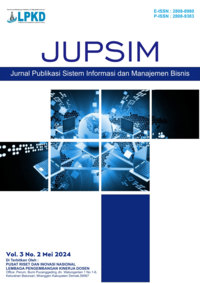Identifikasi Faktor Penentu Kemiskinan di Indonesia Melalui Pendekatan Regresi Linier Berganda
DOI:
https://doi.org/10.55606/jupsim.v4i2.4157Keywords:
Access to Clean Water, Linear Multiple Regression, Population Density, Poverty in Indonesia, Unemployment Rate.Abstract
Poverty in Indonesia remains a significant challenge despite various mitigation programs. This condition is influenced by the complex interaction of social and economic factors, including regional disparities and limited access to basic services. This study aims to identify and analyze the influence of six main factors on poverty levels, namely unemployment rate, average years of schooling, access to clean water, access to healthcare services, per capita GRDP, and population density, using multiple linear regression. The analysis results show that unemployment rate, access to clean water, and healthcare services significantly affect poverty, where higher unemployment and limited access to these services tend to increase poverty levels. Meanwhile, average years of schooling, per capita GRDP, and population density have no significant partial effect. These findings emphasize the importance of policy focus on reducing unemployment and improving access to basic services to effectively lower poverty rates. This study provides an empirical basis for formulating more targeted development strategies to address poverty in Indonesia.
References
Adawiyah, S. El. (2020). Kemiskinan dan faktor-faktor penyebabnya. Journal of Social Work and Social Service, 1(April), 43–50.
Adon, M. J., Jeraman, G. T., & Andrianto, Y. (2023). Kontribusi teori kemiskinan sebagai deprivasi kapabilitas dari Amartya Sen dalam upaya pemberdayaan masyarakat miskin. Masyarakat Madani: Jurnal Kajian Islam dan Pengembangan Masyarakat, 8(1), 1–15. https://doi.org/10.24014/jmm.v8i1.22295
Alifah, A., & Yozza, H. (2020). Faktor-faktor yang mempengaruhi kemiskinan di kota/kabupaten Provinsi Sumatera Barat dengan menggunakan analisis regresi panel. Jurnal Matematika UNAND, 9(1), 53–61. https://doi.org/10.25077/jmu.9.1.53-61.2020
Alkire, S., & Foster, J. (2008). Counting and multidimensional poverty measurement. OPHI Working Paper, 7, 1–34.
Alkire, S., Kanagaratnam, U., & Suppa, N. (2022). The global Multidimensional Poverty Index (MPI) 2022: Country results and methodological note. Oxford Poverty and Human Development Initiative.
Asian Development Bank. (2021). Indonesia: Supporting equitable development through local economic growth.
Badan Pusat Statistik. (2024). Statistik perekonomian Indonesia.
Bappenas. (2020). Rencana Pembangunan Jangka Menengah Nasional (RPJMN) 2020–2024.
Bradshaw, T. K. (2006). Theories of poverty and anti-poverty programs in community development. In 50 Years of Community Development (pp. 98–116). https://doi.org/10.4324/9781003103066-7
Lewis, O. (1966). The culture of poverty, again. Diaspora, Indigenous, and Minority Education, 14(2), 60–69. https://doi.org/10.1080/15595692.2020.1733960
Lubis, N. I., & Kartika, D. (2024). Analisis faktor-faktor yang mempengaruhi kemiskinan di Kabupaten Mandailing Natal menggunakan analisis regresi berganda. Jurnal Ilmiah Matematika, 12(3), 690–696.
Nur, A., & Hendikawati, P. (2024). Faktor dominan yang mempengaruhi kemiskinan kabupaten/kota di Provinsi Jawa Timur tahun 2022. Prosiding Seminar Nasional Matematika, 7, 712–723.
Priseptian, L., & Primandhana, W. P. (2022). Analisis faktor-faktor yang mempengaruhi kemiskinan. Forum Ekonomi, 24(1), 45–53. https://doi.org/10.30872/jfor.v24i1.10362
Sen, A. (1999). Development as freedom. Oxford University Press.
Shorrocks, A., & Townsend, P. (1980). Poverty in the United Kingdom: A survey of household resources and standards of living. The Economic Journal, 90(360), 954–956. https://doi.org/10.2307/2231776
Sianturi, V. G., Syafii, M., & Tanjung, A. A. (2021). Analisis determinasi kemiskinan di Indonesia: Studi kasus (2016–2019). Jurnal Samudra Ekonomika, 5(2), 125–133. https://doi.org/10.33059/jse.v5i2.4270
Sumarto, S., & Suryahadi, A. (2020). Employment, jobs and poverty reduction in Indonesia: The role of labor markets.
Suryadarma, D., Suryahadi, A., Sumarto, S., & Rogers, H. (2020). Improving education in Indonesia: Evidence and policy recommendations.
Suryahadi, A., Hadiwidjaja, G., & Sumarto, S. (2012). Economic growth and poverty reduction in Indonesia before and after the Asian financial crisis. Bulletin of Indonesian Economic Studies, 48(2), 209–227. https://doi.org/10.1080/00074918.2012.694155
United Nations Development Programme (UNDP). (2020). Poverty and inequality in Indonesia: Impacts of COVID-19 and the role of social protection.
Wulansari, R. Y., Fadhilah, N., & Huda, M. (2023). Faktor yang mempengaruhi kemiskinan di Indonesia. Jurnal Ekonomi dan Bisnis, 6(1), 82–95.
Downloads
Published
How to Cite
Issue
Section
License
Copyright (c) 2025 Jurnal Publikasi Sistem Informasi dan Manajemen Bisnis

This work is licensed under a Creative Commons Attribution-ShareAlike 4.0 International License.







